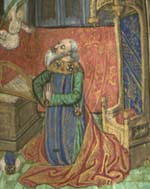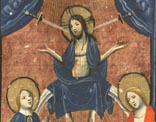Penitential Psalms
Psalms and Sin
Laypeople would recite one or several of the seven Penitential Psalms included in a typical Book of Hours (Psalms 6, 31, 37, 50, 101,129, and 142 in the modern numbering) in order to combat sin and as an act of atonement for their own sins or those of others, decreasing the time spent in Purgatory. The Psalms were believed to have been composed by King David, and many Books of Hours illustrate the opening of the Penitential Psalms either with an image of David sinning (spying on Bathsheba as she bathes) or repenting (kneeling in prayer).King David
 King David coveted Bathsheba, the wife of Uriah, one of his military officers, so he sent the unfortunate husband to war to get him out of the way. When Bathsheba became pregnant, he ordered Uriah to return home, hoping to conceal their sin. Uriah refused to visit his wife, folowing the custom of staying in the military accomodations, so David sent him back with orders that he be placed in the front lines. After his death the adulterers married, but their child was struck down by God, who also visited other punishments upon the nation.
King David coveted Bathsheba, the wife of Uriah, one of his military officers, so he sent the unfortunate husband to war to get him out of the way. When Bathsheba became pregnant, he ordered Uriah to return home, hoping to conceal their sin. Uriah refused to visit his wife, folowing the custom of staying in the military accomodations, so David sent him back with orders that he be placed in the front lines. After his death the adulterers married, but their child was struck down by God, who also visited other punishments upon the nation.
The full-page miniature illustrating the Penitential Psalms has been removed from the Lawrence Hours, but a visual acknowledgement of the king remains. The crown in the margin of the right hand page alludes to both David as the author of the psalms, and to God, the Lord to whom the psalms are addressed.
from the Lawrence Hours, but a visual acknowledgement of the king remains. The crown in the margin of the right hand page alludes to both David as the author of the psalms, and to God, the Lord to whom the psalms are addressed.


